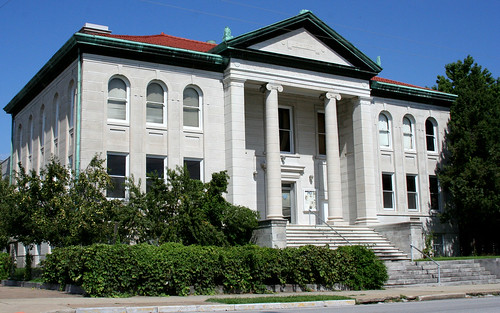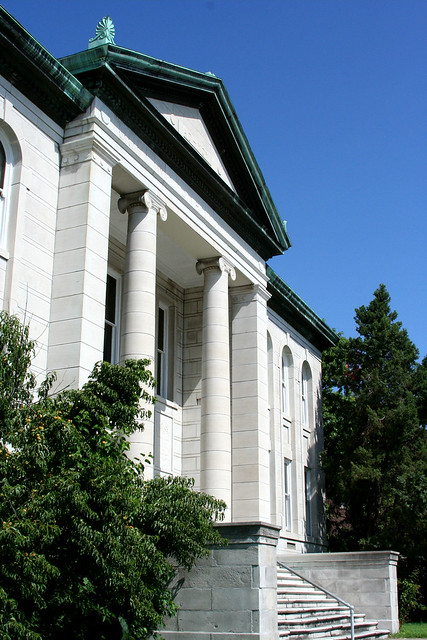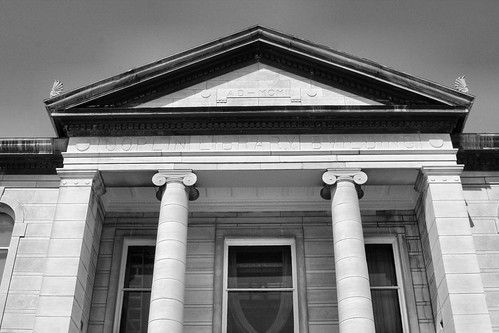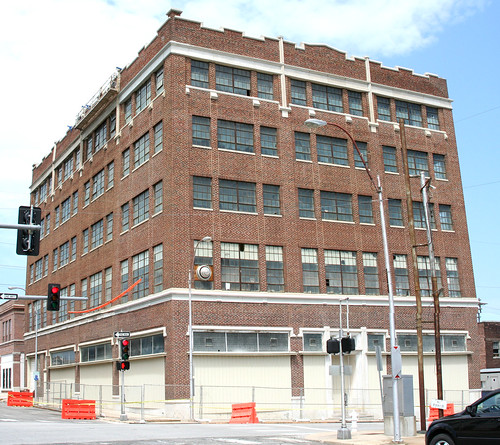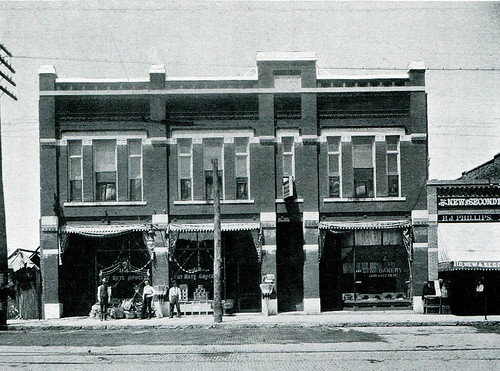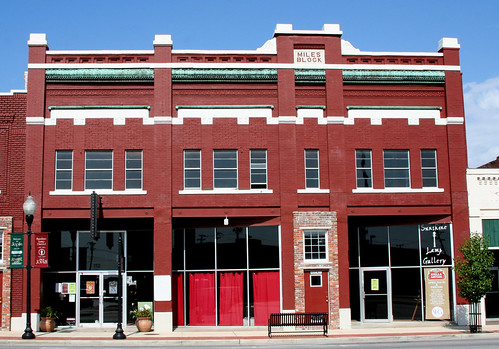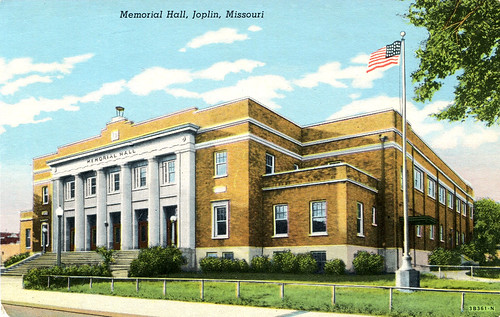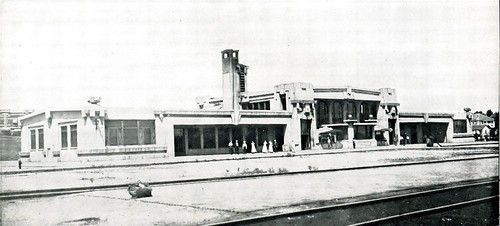Last summer, Historic Joplin wandered about downtown with a camera and one of the stops was the Joplin Carnegie Library, the former home of the Joplin Public Library. Below are a few of the photographs from that visit. Previously, we’ve brought you the history of the library building (here and here), as well a glance at how the library has changed or not changed over the century since its construction. Enjoy!
Downtown Areas Up For Historic Designation
Today’s Joplin Globe features an article on the Missouri Advisory Council on Historic Preservation and its consideration of several areas in downtown Joplin for historic district status. The two areas that the city wants to join the Sunshine Lamp District include an area located between Joplin and Wall and 1st and 3rd streets and would be known as the Joplin and Wall Historic District, the other would be the South Main Street Historic District, an area on the west side of Main Street between 1st and 2nd Streets. If the Missouri Advisory Council on Historic Preservation signs off on these nominations, they would then be forwarded to the Federal Register of Historic Places. If placed on the register, buildings in the districts could qualify for Federal and state tax credits.
Here’s a link to a draft of the Joplin and Wall Historic District nomination.
The draft describes the historic area:
“”The Joplin and Wall Avenues Historic District (Photos 1â€11) consists of an approximately three squareâ€block 5â€acre area in the northern reaches of the central business district of Joplin, which is in Jasper County, in southwestern Missouri. The district is topographically flat and contains a total of 13 buildings dating from c. 1900 through the 1930s, all of loadâ€bearing masonry construction, flatâ€roofed, and ranging in height from one story to five stories; no residential buildings are in the district. (continued below…)
“(continued…) The nominated area is located along a grid of three blocks of Joplin and Wall Streets which run northâ€to south and are intersected by West First, West Second, and West Third Streets and unnamed alleys running both northâ€south and eastâ€west. Of the 13 buildings in the district one, the Joplin Supply Company (Resource No. 13; Photos 3, 6), was previously listed in the National Register (NR 2007). Of the remaining 12 unlisted buildings, 11 contribute to the character of the district and one is a noncontributing element with reference to the district as a whole. The overall appearance of the district is entirely commercial, lacking landscaping and characterized by a grid of paved streets and alleys, concrete sidewalks, with most buildings built flush with one another. Some buildings have associated surface parking; the largest vacant parcel is associated with a 1936 former bus depot (Resource No. 5); this parcel was used historically for bus parking.”
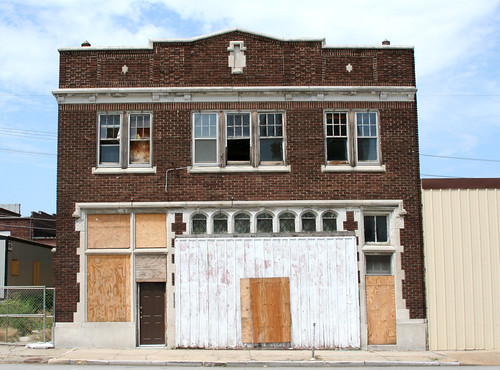
Hulbert Chapel, next door to the Joplin Supply Company building is also part of the nominated Joplin and Wall District
The draft provides a list of the properties, a brief description of each, as well some history. Such recognizable buildings are the Joplin Supply Company building, the Greyhound Bus Depot across from the library, and the old court house post office building.
Here’s the link to the draft for the nomination of the South Main Historic District.
The draft describes the area as:
“The South Main Street Historic District (Photos 1â€8; Figs. 1â€4) is located in the City of Joplin, Jasper County, in southwestern Missouri. This oneâ€block long linear district encompasses less than one acre and occupies all of the west side of South Main Street between West First and West Second Streets and consists entirely of commercial architecture dating from the turn of the twentieth century through c. 1910. The district is located at the northern periphery of the central business district and contains ten buildings of one and two stories in height, all of loadâ€bearing masonry construction. Two buildings are nonâ€contributing elements within the context of the district as a whole and the remaining eight are contributing.
The district retains the characteristic dense concentration of development which typifies most downtown areas, with all buildings constructed without frontâ€lot setback. Rearâ€lot setbacks vary
from building to building, and surface parking is provided behind most properties. All but two of the district’s buildings are built flush with one another; two adjacent buildings are separated by a narrow walkway. The district fronts on South Main Street, West First and Second Streets form the district’s north and south boundary, respectively, and an unnamed alley establishes the district’s western boundary. New construction and vacant lots are immediately adjacent to the nominated district, and the Joplin and Wall Avenues Historic District, nominated concomitant with this district but distinct in its own right, is to the west.”
The district primarily concerns the strip of beautiful buildings on the west side of Main Street from 2nd street up that include the striking Miles Block.
For those of you interested in learning more about the architecture used in the construction of these buildings, as well as for some brief histories, we encourage you to read the drafts in greater detail. The Council will meet this Friday to discuss the nominations.
Joplin Museum Complex Proposal Shot Down
We would be remiss if we did not mention the recent Joplin Museum Complex proposal that was defeated at the polls.
Yesterday, Joplin held its spring election and arguably the most contentious item on the ballot was Proposition A, which if passed would have created a sales tax to fund a $7 million dollar renovation of Memorial Hall to serve as the new home of the Joplin Museum Complex. The sales tax would have indefinitely continued at a lower rate to perpetually support the museum. The proposal was voted down.
According to the Joplin Globe, the vote was 3,882 to 928, a four to one margin. While we here at Historic Joplin believe that the museum complex could do with a new home, we agree with the result of the vote. There are several reasons why.
First, it was a poor decision to spearhead a sales tax proposal during the recent recession. Although many economists believe the country is recovering from the recent economic downturn, folks on Main Street are still feeling the pain of difficult times. A new museum complex is the least of someone’s worries who is struggling to pay for healthcare, food, and other necessities. Simply put, it’s hard to justify passing a new tax on people who are struggling to survive on a daily basis.
Second, the PR campaign was mediocre at best. The Globe, which seemed to support the museum proposal, attempted to publicize both sides of the debate. The museum, however, failed to articulate to the public why it matters. Talking about the museum’s multi-million dollar collection of lead and zinc samples does not translate with folks. It does not inspire passionate debate. In the end, the museum failed to carry its message to the people, let alone sell it.
Third, the museum awkwardly proposed taking over Memorial Hall. Why? It appears that “museum representatives” decided upon Memorial Hall and drew up plans without even consulting the public. Some of the endorsements on its website are questionable, even dubious at best, such as the “National Cookie Cutter Historical Museum,” and the “Joplin Historical Society.” It is our understanding that the National Cookie Cutter Museum is part of the Joplin Museum Complex as is, or was, the Joplin Historical Society. Essentially, two organizations that are part of the museum were supporting the museum proposal — isn’t that a conflict of interest?
Fourth, we here at Historic Joplin have conducted research in many of the finest archives and libraries in the world such as the Bodleian Library at Oxford; National Archives I and II in Washington, D.C. and College Park, Maryland; the Library of Congress; the special collections of the University of Oklahoma, the University of Missouri, and the University of Arkansas; numerous state archives and county courthouses; as well as small town libraries and museums. We can say that we have always had a pleasant experience save for interactions with the Joplin Museum Complex.
The Joplin Museum Complex does not allow members of the public access to its collections which is extremely unfortunate. Excuses are made that the museum is simply unable to accommodate visitor requests for access to the museum’s collection. This is unacceptable. Dorothea B. Hoover is rolling in her grave. Years ago, the University of Arkansas Museum was shuttered and the multi-million dollar collection placed in storage. Although housed in a very small space, the university museum collection is readily accessible to the public and is cared for by professional museum staff.
We cannot say the same of the Joplin Museum Complex (JMC). The photo in the recent Globe article on the museum shows that the Joplin Museum Complex collection has not been taken care of by the museum staff. Even if the conditions are not ideal, there is no excuse for sloppy storage methods, although the JMC staff members are not professionally trained curators or archivists. Out of the many libraries, museums, and archives we have visited over the years, this is the first time we encountered such an unhelpful staff. It is unacceptable that members of the public are denied access to museum collections when it is funded by taxpayer money.
So here are our suggestions for improvement:
First, the next time the Joplin Museum Complex embarks on a fundraising campaign, it must articulate its message. Tell the public why its collections matter. Sell it like Sam Walton sold cheap underwear back in the 1970s.
Second, the Joplin Museum Complex should get rid of collections that have nothing to do with the history of Joplin such as the Cookie Cutter collection in order to create adequate storage space. In the museum world, this is called “deaccessioning.” Every museum will deaccession something in its lifetime, particularly items that do not fit with the museum’s mission. Is the Cookie Cutter collection relevant to the history of Joplin? Probably not. So get rid of it. Focus on the real treasures in the collection. This should alleviate some of the storage problems.
Third, please change exhibits as time and money allows. The Joplin Museum Complex has not changed since I was in the third grade. Consider not allowing an animal to run around the museum as they can damage and ruin museum artifacts. No museum staff worth its salt lets live animals have free reign inside of a museum.
Fourth, consider the Union Depot. We realize it is a shell of a building. We have read that the basement has water problems. It is, however, an architectural jewel waiting to be reclaimed. The Joplin Museum Complex could have gotten a lot of support from the numerous voters who want to see the Union Depot restored to its former glory. Forget the basement. Pour concrete in the basement for all we care. Any architect worth his or her drawing board can come up with architectural additions that will compliment Union Depot’s fabulous design. Incidentally, it was in the Kansas City Bottoms where Union Depot sits, where some of Joplin’s first lead mines were established. Think of how relevant that is to the history of Joplin — what better location to preserve and explain the history of Joplin and its rough and tumble beginnings? Plus, the Joplin Museum Complex would be a hero for saving the depot.
Fifth, contemplate hiring someone to serve as museum director who has demonstrated experience in fundraising, community relations, and who preferably has a master’s degree in museum studies.
Comments? Thoughts? Let us know.
